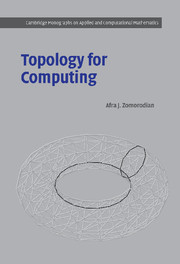5 - Morse Theory
Published online by Cambridge University Press: 19 August 2009
Summary
In the last two chapters, we studied combinatorial methods for describing the topology of a space. One reason for our interest in understanding topology is topological simplification: removing topological “noise,” using a measure that defines what “noise” is. But as we saw in Section 1.2.3, the geometry and topology of a space are intricately related, and modifying one may modify the other. We need to understand this relationship in order to develop intelligent methods for topological simplification. Morse theory provides us with a complete analysis of this relationship when the geometry of the space is given by a function. The theory identifies points at which level-sets of the function undergo topological changes and relates these points via a complex. The theory is defined, however, on smooth domains, requiring us to take a radical departure from our combinatorial focus. We need these differential concepts to guide our development of methods for nonsmooth domains. Our exposition of Morse theory, consequently, will not be as thorough and axiomatic as the accounts in the last two chapters. Rather, we rely on the reader's familiarity with elementary calculus to focus on the concepts we need for analyzing 2-manifolds in ℝ3.
We begin this chapter by extending some ideas from calculus to manifolds in Sections 5.1 and 5.2.
- Type
- Chapter
- Information
- Topology for Computing , pp. 83 - 93Publisher: Cambridge University PressPrint publication year: 2005



